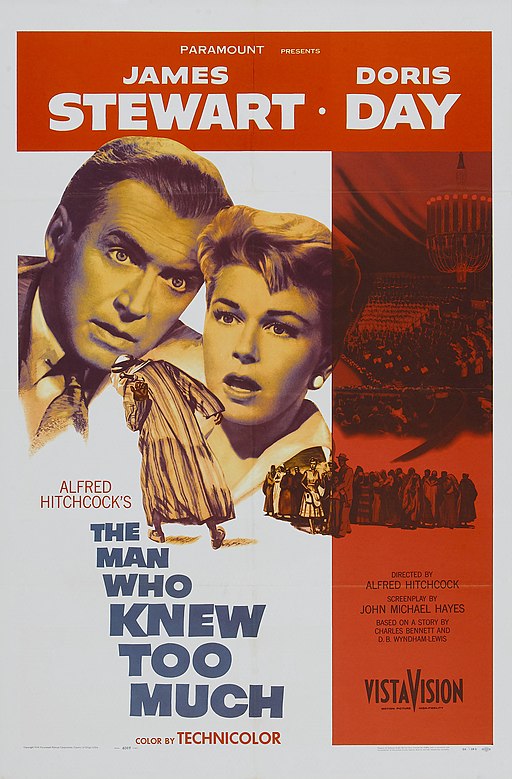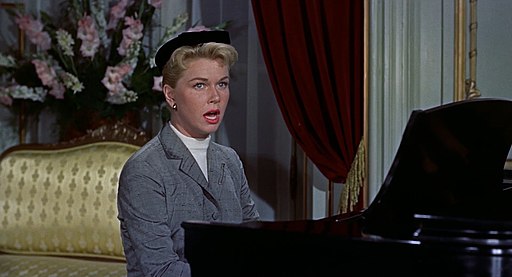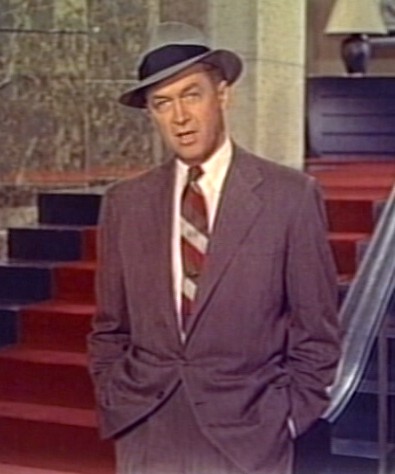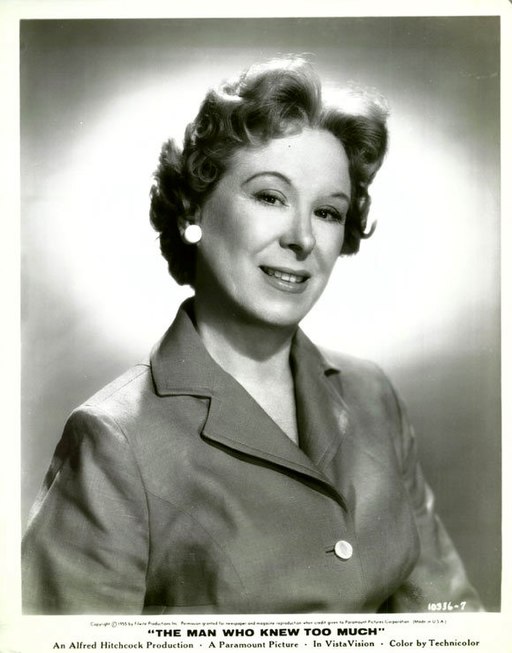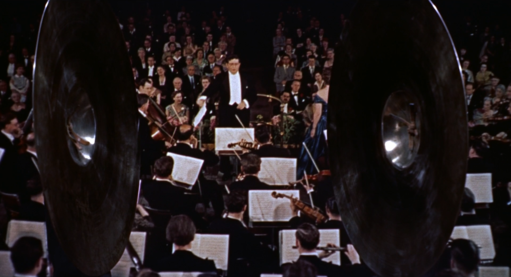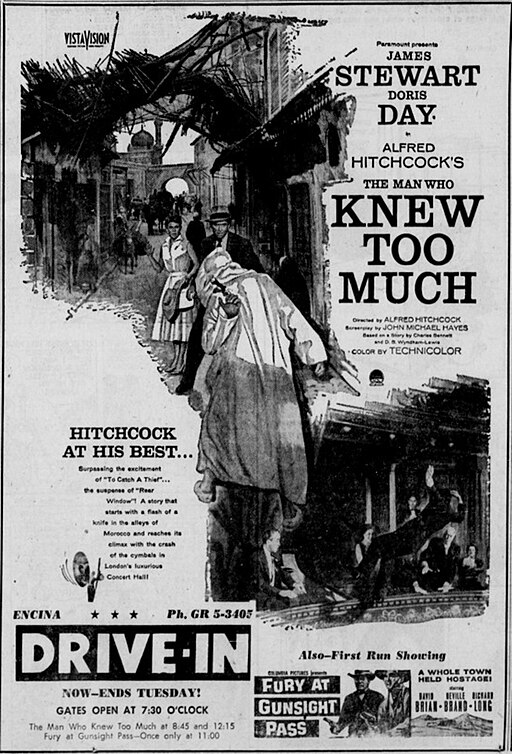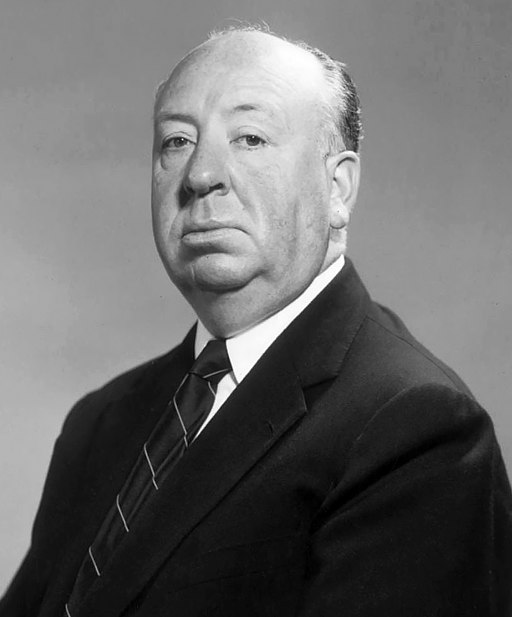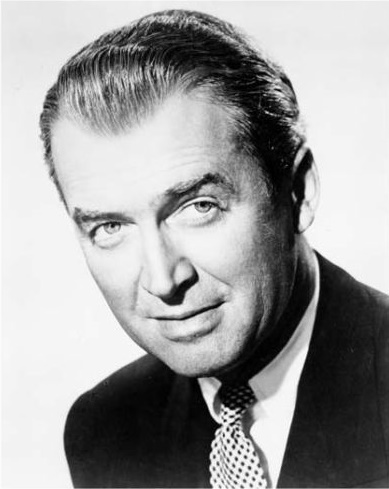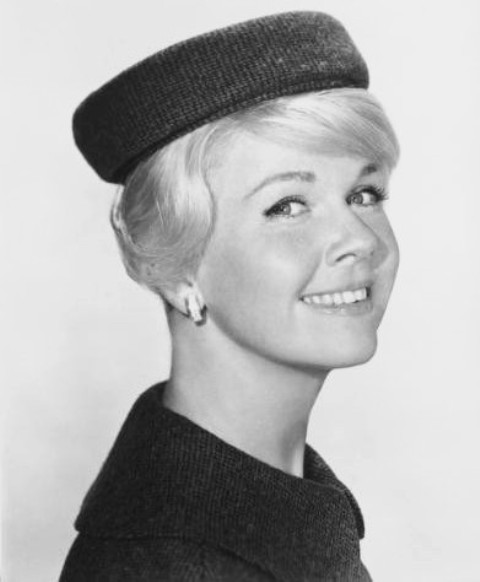The Man Who Knew Too Much - 1956
back| Released by | Paramount Pictures |
| Director | Alfred Hitchcock |
| Producer | Alfred Hitchcock |
| Script | John Michael Hayes, based on a story by Charles Bennett and D.B. Wyndham-Lewis |
| Cinematography | Robert Burks |
| Music by | Bernard Herrmann; the film famously includes the song |
| Running time | 120 minutes |
| Film budget | $1,2 million |
| Box office sales | $10 million |
| Main cast | James Stewart - Doris Day - Brenda de Banzie - Bernard Miles - Christopher Olsen |
The Man Who Knew Too Much
An Ordinary Family entangled in Extraordinary International Intrigue
This movie is a remake of Hitchcock's own 1934 film of the same name. It's notable for its suspenseful plot, innovative cinematography, and the use of locations such as the Royal Albert Hall in London.
The film is also remembered for its famous climax and the song "Que Sera, Sera," which became a huge hit and is strongly associated with Doris Day.
Related
The Man Who Knew Too Much – 1956
Summary:
Plot Overview: The film follows an American family on vacation in Morocco. Dr. Benjamin McKenna, his wife, Josephine Conway McKenna, a famous singer, and their son Hank become inadvertently involved in international intrigue.
In Morocco: While in Marrakesh, they befriend a Frenchman, Louis Bernard. Unbeknownst to them, Bernard is an undercover French Intelligence agent. One evening, Bernard is fatally stabbed in a crowded marketplace but manages to whisper a dying message to Ben about an assassination plot in London.
Kidnapping of Hank: The McKennas are shocked when their son Hank is kidnapped to ensure their silence. The couple then travels to London, trying to decipher Bernard's cryptic message while desperately searching for their son.
Investigation and Clues: In London, the McKennas encounter the Draytons, a seemingly friendly English couple who are actually part of the assassination plot. Through a series of suspenseful events, Jo deduces that the Draytons are the kidnappers.
Royal Albert Hall Scene: The film reaches its climax at the Royal Albert Hall. Jo and Ben discover that the assassination is to occur during a concert. In a tense sequence, Jo, recognizing the cymbal clash that will signal the assassination, screams, disrupting the assassin's aim and preventing the murder.
Rescue and Resolution: The McKennas follow the kidnappers to a church where they are holding Hank. In a dramatic confrontation, the police arrive, and Hank is rescued. The film concludes with the family safely reunited.
Analysis:
- Suspense and Ordinary People in Extraordinary Circumstances: True to Hitchcock's style, the film masterfully creates suspense by placing ordinary people in extraordinary situations. The viewer empathizes with the McKennas’ parental fears, heightening the tension.
- International Intrigue and Cold War Paranoia: The film reflects the Cold War era's paranoia, with its plot revolving around international espionage and assassination.
- Cinematography and Set Pieces: Robert Burks' cinematography is notable, especially in the Marrakesh scenes and the Royal Albert Hall sequence, which is a masterclass in building suspense without dialogue.
- Music: Bernard Herrmann's score adds to the film's tension, and the use of "Que Sera, Sera" serves both as a plot device and an emotional anchor.
- James Stewart and Doris Day: Stewart's everyman persona and Day's emotional depth as a mother bring authenticity to the narrative. Their performances anchor the film, making the fantastical plot seem believable.
- Iconic Scenes: The Royal Albert Hall scene remains one of the most celebrated in Hitchcock's oeuvre for its orchestration of suspense.
- "Que Sera, Sera": The song won the Academy Award for Best Original Song and became indelibly linked to Doris Day.
Conclusion:
"The Man Who Knew Too Much" stands as a testament to Hitchcock's ability to weave intricate plots with compelling characters, making it a classic in the thriller genre. Its blend of suspense, music, and performance showcases Hitchcock's directorial prowess and continues to influence filmmakers and thrill audiences.
Original Theatrical Trailer from 1956:
Full Cast of “The Man Who Knew Too Much”:
- James Stewart as Dr. Benjamin McKenna
- Doris Day as Josephine Conway McKenna
- Brenda de Banzie as Lucy Drayton
- Bernard Miles as Edward Drayton
- Ralph Truman as Inspector Buchanan
- Daniel Gélin as Louis Bernard
- Mogens Wieth as Ambassador
- Alan Mowbray as Val Parnell
- Hillary Brooke as Jan Peterson
- Christopher Olsen as Hank McKenna
- Reggie Nalder as Rien
- Richard Wattis as Assistant Manager
- Noel Willman as Woburn
- Alix Talton as Helen Parnell
- Yves Brainville as Police Inspector
- Carolyn Jones as Cindy Fontaine
- Clinton Sundberg as Taxidermist
- Louise Lorimer as the McKenna's Neighbor
- Donald Lawton as the Butler
- Lois Corbett as the Nurse
- Wolfe Morris as a Guard at the Embassy
- Peter Camlin as the Edington Chauffeur
- Frank Atkinson as a Policeman
Differences between the 1934 and 1956 Version:
Alfred Hitchcock directed two versions of "The Man Who Knew Too Much," the first in 1934 and the second in 1956. While both films share the same basic premise, there are significant differences between the two:
Setting and Characters:
- 1934 Version: Set primarily in Switzerland and England, featuring British characters. The protagonists are Bob and Jill Lawrence, played by Leslie Banks and Edna Best.
- 1956 Version: Set in Morocco and London, featuring American protagonists, Dr. Ben McKenna and his wife, Josephine Conway McKenna (a famous singer), played by James Stewart and Doris Day.
Plot and Storyline:
- 1934 Version: Involves the attempted assassination of a European head of state, which the Lawrences accidentally learn about. Their daughter Betty is kidnapped to ensure their silence.
- 1956 Version: The plot centers around the planned assassination of a foreign prime minister. The McKennas' son, Hank, is kidnapped for the same reason as in the earlier film.
Climactic Scene:
- 1934 Version: The climax occurs in the Royal Albert Hall, similar to the 1956 version. However, it's shorter and less elaborate.
- 1956 Version: Features an extended and more dramatically intense climax at the Royal Albert Hall, showcasing Hitchcock's evolved filmmaking style and technical advancements.
Musical Element:
- 1934 Version: Does not have a significant musical element integral to the plot.
- 1956 Version: Music plays a crucial role, especially the song "Que Sera, Sera," sung by Doris Day's character. The song becomes a key plot device and adds emotional depth.
Technological and Stylistic Differences:
- 1934 Version: Made in the early sound era of cinema, it exhibits the limitations and style of filmmaking of that period.
- 1956 Version: Benefits from two decades of technological advancements in film, including color cinematography and improved sound recording. Hitchcock's direction also shows more sophistication and flair in the latter film.
Reception and Impact:
- 1934 Version: Considered a significant early work of Hitchcock but not as widely known or acclaimed as the later version.
- 1956 Version: Gained more popularity and acclaim, partly due to the star power of James Stewart and Doris Day and the more polished production values.
Personal Preference of Hitchcock:
- Hitchcock himself expressed a preference for the 1956 version, citing its higher production values and his greater experience and skill as a filmmaker by that time.
In summary, while both versions of "The Man Who Knew Too Much" share a core story, the differences in setting, characters, technological sophistication, and the use of music significantly distinguish the 1956 version from its 1934 predecessor. The latter is often regarded as a more polished and emotionally resonant rendition of the story.
Analysis of the Directing Style of Alfred Hitchcock:
Alfred Hitchcock, often hailed as the "Master of Suspense," is renowned for his unique and influential approach to film direction. His work in "The Man Who Knew Too Much" (1956) is a quintessential example of his directorial style and techniques. Here's an analysis of Hitchcock's direction in this film:
Visual Storytelling and Cinematography:
- Controlled Visual Composition: Hitchcock was known for his meticulous storyboarding and framing. In "The Man Who Knew Too Much," each frame is carefully composed to enhance the narrative. Hitchcock's use of close-ups, especially in tense moments, draws the audience into the emotional state of the characters.
- Use of Locations and Sets: The film's diverse settings, from the exotic streets of Marrakesh to the grandeur of the Royal Albert Hall, are used effectively to create a sense of scale and realism. Hitchcock's ability to use these locations to heighten suspense is evident throughout the film.
Mastery of Suspense and Pacing:
- Building Tension: Hitchcock's trademark technique is his ability to build suspense. He often does this by providing the audience with more information than the characters have, creating a sense of anticipation and anxiety. In this film, the Royal Albert Hall sequence is a masterclass in suspense, with the audience aware of the impending assassination attempt while the characters slowly piece it together.
- Pacing: Hitchcock carefully paces the film to balance moments of high tension with periods of calm. This pacing keeps the audience engaged and on edge, never quite sure what will happen next.
Psychological Depth and Character Development:
- Complex Characters: Hitchcock's characters are often complex, with intricate backstories and motivations. In "The Man Who Knew Too Much," the McKennas are not just stereotypical tourists; they have depth, fears, and a protective instinct for their child.
- Emotional Engagement: Hitchcock's direction ensures that the audience is emotionally invested in the characters' journey. The desperation of the McKennas in finding their son makes the audience empathize with their plight, adding to the film's emotional impact.
Innovative Use of Sound and Music:
- Diegetic and Non-Diegetic Sound: Hitchcock was a pioneer in using sound to enhance the storytelling. The mix of diegetic sound (like the cymbals in the concert scene) and non-diegetic sound (the film's score) is used to heighten the tension.
- Iconic Music Integration: The integration of "Que Sera, Sera" into the plot is both a narrative device and a tension-building element. This song becomes a crucial part of the story, showcasing Hitchcock's skill in using music to further the plot.
Legacy and Influence:
- Innovative Techniques: Hitchcock's innovative camera techniques, such as the use of zooms, tracking shots, and high-angle shots, have influenced generations of filmmakers.
- Genre Defining: Hitchcock didn't just make thrillers; he defined what a thriller could be. His films blend suspense, drama, and, often, dark humor in a way that was groundbreaking for the time.
Impressive Performance of Doris Day:
Doris Day's performance in Alfred Hitchcock's "The Man Who Knew Too Much" (1956) is a pivotal element of the film, showcasing her range as an actress and her unique ability to blend emotion, strength, and musical talent. Here's a descriptive analysis of her performance:
Emotional Depth and Versatility:
- Portrayal of Josephine Conway McKenna: Day plays the role of Josephine (Jo) Conway McKenna, a famous singer turned devoted wife and mother. Her portrayal is nuanced, reflecting both the vulnerability and resilience of her character.
- Range of Emotions: Throughout the film, Day seamlessly transitions between moments of tenderness, fear, despair, and determination. Her emotional depth is particularly evident in scenes where she grapples with the kidnapping of her son, conveying a sense of authentic maternal anxiety and desperation.
Subtle Strength and Complexity:
- Strength Under Pressure: Day's performance brings a subtle strength to her character. Jo McKenna is not just a distressed mother; she is resourceful and courageous, particularly in the face of danger. This complexity adds a layer of realism to her character.
- Complex Character Dynamics: Day skillfully portrays the complexities of her character's relationships, especially with her husband (played by James Stewart). Their on-screen chemistry adds depth to the narrative, highlighting the strain and solidarity in their marriage amidst the crisis.
Musical Talent:
- "Que Sera, Sera (Whatever Will Be, Will Be)": One of the most iconic aspects of Day's performance is her rendition of "Que Sera, Sera." This song not only showcases her singing talent but also becomes a crucial plot device in the film. Her emotive delivery of the song resonates with both a sense of foreboding and comfort, encapsulating the film's themes of fate and uncertainty.
Contribution to Suspense and Tension:
- Building Tension: Day's ability to convey fear and anxiety contributes significantly to the film's suspense. Her reactions and expressions in critical scenes, like the Royal Albert Hall sequence, heighten the tension for the audience.
- Relatability: Day brings a relatable and human element to the story. Her portrayal makes the audience empathize with her character's plight, drawing them deeper into the narrative.
Legacy and Impact:
- Memorable Performance: Day's performance in this film stands out in her career, showcasing her as more than just a musical star but a versatile actress capable of handling complex roles in different genres.
- Impact on Hitchcock's Work: In a filmography often dominated by Hitchcock's "cool blondes," Day's warm and emotive performance adds a different dimension to the typical Hitchcock female protagonist.
In summary, Doris Day's performance in "The Man Who Knew Too Much" is a testament to her talent as an actress and a singer. She brings a multifaceted depth to her character, blending emotional intensity with a strong will, making her role memorable and significant in the context of the film and her overall career.
Notable Quotes from the Film:
Dr. Ben McKenna (James Stewart): "Sorry we were gone so long, but we had to pick up Hank."
- Context: This line, delivered with a casual air, belies the intense struggle the McKennas went through to rescue their son, encapsulating Hitchcock's knack for understated yet impactful dialogue.
Josephine Conway McKenna (Doris Day): "You're the man who knows too much."
- Context: This line is key to the film's title and theme. It's spoken to Dr. Ben McKenna, reflecting the dangerous knowledge he unwittingly acquires and its consequences.
Dr. Ben McKenna: "Sorry, we don't want to buy anything, and we gave at the office."
- Context: This line is an example of Hitchcock's use of humor to diffuse tension, showing Dr. McKenna's attempt to maintain normalcy and wit even in bizarre and dangerous situations.
Josephine Conway McKenna: "Hank, don't you remember what I told you about how nothing's ever all good or all bad? That's true about people too."
- Context: This quote reflects Jo's wisdom and her attempts to teach her son about the complexities of life, adding depth to her character as a caring mother.
Lucy Drayton (Brenda de Banzie): "A little ride in the country might do you a lot of good."
- Context: Spoken by Lucy Drayton, this line carries an eerie undertone as it foreshadows the impending danger and intrigue that the McKennas will soon face.
Dr. Ben McKenna: "I could tell you what's happening, but I don't think it'd make you feel any better."
- Context: This line highlights the tension and uncertainty that Dr. McKenna faces, as he grapples with the dilemma of whether to share disturbing information with his wife.
Singing of "Que Sera, Sera (Whatever Will Be, Will Be)" by Doris Day:
- Context: Although not a spoken quote, the recurring song becomes a thematic element in the film, symbolizing the theme of fate and the acceptance of the unknown.
Awards and Recognition:
Academy Awards (Oscars):
- Won: Best Original Song for "Que Sera, Sera (Whatever Will Be, Will Be)" performed by Doris Day. The song, written by Jay Livingston and Ray Evans, won the Oscar for Best Original Song in 1957.
Other Nominations and Awards:
As for other major film awards like the BAFTAs, Golden Globes, or Cannes Film Festival, "The Man Who Knew Too Much" did not receive nominations in these venues. However, it's important to note that during the 1950s, the scope and number of film awards were more limited than they are today.
The film's most significant achievement, aside from its box office success and critical acclaim, remains its Oscar win for "Que Sera, Sera." This song not only contributed to the film's legacy but also became a timeless classic, often associated with Doris Day's career.
While the film itself did not garner a multitude of awards, its impact on cinema, particularly in the thriller genre, and its status as a classic Hitchcock film is well-recognized.

